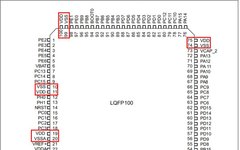Why Does the STM32 Chip Have So Many VDD Pins?
Friends who have worked with microcontroller products know that the STM32 chip has multiple VDD and VSS pins, as shown in the figure below: So why are there so many pins? Wouldn’t it be better to have fewer? Fewer pins make PCB routing easier. Actually, there are reasons for the chip being designed this way. … Read more



